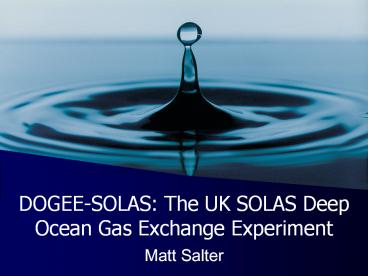DOGEE-SOLAS: The UK SOLAS Deep Ocean Gas Exchange Experiment - PowerPoint PPT Presentation
Title:
DOGEE-SOLAS: The UK SOLAS Deep Ocean Gas Exchange Experiment
Description:
Marine source of major greenhouse gases such as nitrous oxide and methane ... Professor Rob Goddard. Dr Phil Nightingale, PML. Dr Jo Dixon,PML. Dr Alex Baker, UEA ... – PowerPoint PPT presentation
Number of Views:36
Avg rating:3.0/5.0
Title: DOGEE-SOLAS: The UK SOLAS Deep Ocean Gas Exchange Experiment
1
DOGEE-SOLAS The UK SOLAS Deep Ocean Gas Exchange
Experiment
- Matt Salter
2
Overview
- Why is gas exchange important?
- What determines gas exchange?
- What can we measure?
- What controls kw?
- The problem
- This project- the solution?
- What will we do?
- The tracer release
- Surfactants
- Further aims
3
Why is gas exchange important?
- Gas exchange is an important term in many
biogeochemical cycles but remains a major
uncertainty - Many important issues require accurate estimates
of gas exchange rates - CO2 uptake by oceans
- Marine source of major greenhouse gases such as
nitrous oxide and methane - Climate forcing involving DMS and iodocarbons
4
What determines gas exchange?
- Gas exchange is determined by
- the concentration difference between the
atmosphere and the surface ocean. This drives the
flux of gases - a kinetic transport term known as the gas
transfer velocity, kw which is a function of the
interfacial turbulence
?C
5
So what can we measure?
- Measuring the concentration driven gas flux is
relatively easy - However kw can only be estimated indirectly hence
quantifying it is problematic - Kw is a function of turbulence resulting from
complex interactions between several forcings
6
The controls
- Wave geometry
- Sea surface roughness
- Wave breaking
- Bubbles
- Rainfall
- Surfactants
- As many of the controls appear largely wind
driven it was logical to derive simple empirical
relationships for kw based upon wind speed
7
- But...
8
The problem
- Non-linear nature
- Strong divergence between predicted kws,
especially at high wind speeds - No agreement if any of the relationships are
correct - It would seem that using wind speed alone to
predict kw is impossible
Figure 1. kw vs wind speed parameterisations
where k600 is a normalised value of kw
9
- So...
10
We will measure kw
- We will utilise a dual tracer method to obtain
indirect estimates of kw at sea during two
cruises in the North Atlantic in December 06 and
May 07
11
The tracer release
- Involves a simultaneous release of two inert,
non-toxic gaseous tracers SF6 and 3He - The two gases are dissolved in a gas-tight tank
of water through a headspace
SF6
3He
The ratio of SF6 concentration to 3He is measured
12
The tracer release
- The tracers are then displaced by pumping
seawater into the tank and are deployed at the
release site
13
The tracer release
- The tracers then become diluted due to horizontal
and vertical mixing and loss through air-water
exchange
However 3He diffuses more rapidly than SF6 across
the air-water interface
- Thus values for kw can be calculated from the
change in ratio of the two tracers over time
14
The effect of surfactants
- On the second cruise we plan to release two
tracer patches in close proximity, one of which
will be labeled with a surfactant (a surrogate
for natural sea surface surfactants)
- This will mimic the role of natural surfactants
in modifying gas transfer - We will compare the gas exchange data for the two
patches- the first time this will have been
attempted in the field
Tracer patch without surfactant
Tracer patch labeled with surfactant
15
The effect of surfactants
- I would also like to quantify and characterise
natural surfactants sampled from the microlayer
as much as possible during the cruise - I hope to achieve this using polarography, an
electrochemical method
16
A.C. Polarography
- Surfactants reduce the capacitance C formed by
the Hg surface and the electrolytic double layer - A relationship exists between the surfactant
concentration c in the electrolyte and the
density of the deposited material, and therefore
also between c and C - This is expressed by an adsorption isotherm, E vs
C
17
Summary and further aims
- We will measure kw indirectly during two cruises
in the North Atlantic - We will investigate the role of surfactants on kw
in the field - During the same cruises, other groups will be
investigating the role of other controlling
variables on kw - In the end, we hope to combine all this data in
order to gain a clearer picture of the controls
on kw
18
Acknowledgments
- NERC
- PML for use of their facilities
- Professor Rob Goddard
- Dr Phil Nightingale, PML
- Dr Jo Dixon,PML
- Dr Alex Baker, UEA































